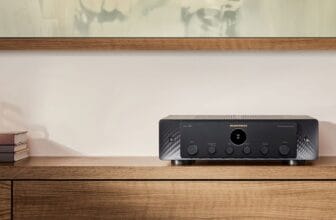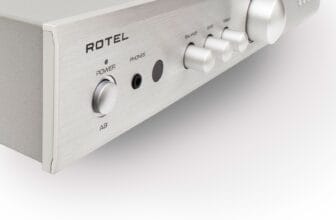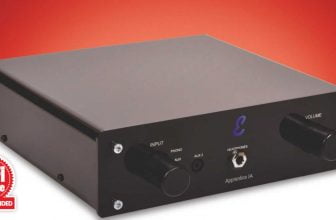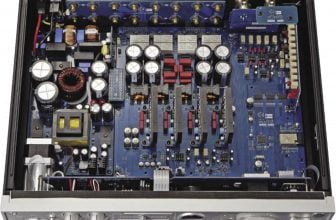Creek voyage i20 Review – Easy Voyage
Noel Keywood lives with the new Creek Voyage i20 amplifier and finds it easy going. Read our Creek voyage i20 Review.
Creek’s latest Voyage i20 amplifier I’m reviewing here reminded me of their first amplifier, the CAS4040 from 1982. What that simple but clever design did was reproduce music without nasties – no gritty transistor distortion. The Voyage i20 carries on the Creek sound with exemplary ability.
And there’s good reason. It is Mike Creek. Still very much in charge today, his knowledge of audio amplifier design is extraordinary – as I know from long and intense explanations to me about where every electron was going and how it should behave!
In the new Voyage i20 that’s a lot more places to go and many more ways to behave – and there is big price increase as a result. Where Creeks have been affordable in the past, £ for the CAS4040 in 1982 equating to £ today (Bank of England inflation calculator) and our Evolution 100A costing £ when reviewed in our March 2015 issue, the new i20 has become in Creek’s own words “a premium product”.
This is a powerful ‘digital’ amplifier, meaning it has an on-board digital section, unlike the Evolution 100A we have heavily used as a reference amplifier from some years now. I’ve been writing about ‘digital’ amps recently as they are morphing into an interesting place to be. Until recently their on-board digital-to- analogue convertors (DACs) have been a low-cost addition unable to compete with more sophisticated and expensive external DACs, but that is changing. Audiolab, Quad and Leak are all now using acclaimed ESS DAC chips, whilst Creek have chosen to use an AK4493EQ DAC chip from Asahi Kasei Microsystems (AKM, Japan) they tell me. This is a premium chip, part of AKM’s Velvet Sound range that I know well justifies the title; they are even more “velvety” in sound than ESS chips, albeit by minor degree. But a top chip all the same, with quoted 123dB dynamic range – as you might hope in a premium priced amplifier.
From a compact chassis measuring 430mm wide, 80mm high and 350m deep the i20 delivers 120 Watts into 8 Ohms and 225 Watts into 4 Ohms our measurements showed – in line with Creek’s claimed power output. As today’s loudspeakers are rated as 6 Ohms nominal make the power figure 155 Watts then – more than enough to go very loud.
But hey! The i20 is smaller than our 100 Watt Evolution 100A. How come? Purists will need to take a deep breath: it uses a switch-mode power supply. No big toroidal mains transformer any more, with consequent

shrinkage in weight and size. It’s a custom design they told us, allowing the amplifier to handle low loads with ease, with minimal power reduction.
In keeping with price, the i20’s front panel is slickly sculpted and finished, a work of art. The rear case is a conventional pressed steel type with heavy folded steel cover. There’s a master power (rocker) switch at rear and a soft-start at front on the left rotary control. These functions also exist on a supplied remote control. The left rotary primarily selects inputs, but it has a push-to-select function that brings up a Menu on the display panel with various adjustable settings. Those that caught my attention were five PCM digital filters (Sharp, Sharp+, Slow, Slow+, Natural), plus two DSD filters (Wide, Narrow). There are also gain settings to increase sensitivity, only available in start-up mode, not in main Menu.
Some peculiarities. The i20 has an optional plug-in phono stage board for LP and ours was so fitted. The website mentions “RIAA filtering, to reduce disc warp frequencies” but this is not available from the Menu (software control), only on the internal Phono circuit board (hardware control), meaning the cover must be removed to get at it – best left to a dealer.
The Manual says there are six PCM filters but our full production sample had five, with different naming. Changing filter produced no effect; it appeared stuck on Slow under tests, when I was using the rotary selector at left. The remote control did, however, work and measurement showed that with CD, Natural most strongly rolled off upper treble, Slow and Slow+ were less aggressive at doing so, whilst Sharp and Sharp+ extended response to 21 kHz with just slight roll down to take out the sting out of CD. The lack of correlation between handbook and production suggested to me the i20 was being built and programmed by a sub-contractor and a quick ferret around revealed it is made in the Czech Republic.
What I noted immediately is that the single pair of XLR-socket balanced inputs now run through the volume control (they did not on the Evolution 100). There are four standard (unbalanced) Line inputs, one of which is occupied by the Phono stage board when fitted. Digital inputs comprise two opticals (TOSLINK), two electricals (phono sockets) and one USB. The AKM DAC chip has on-board DSD decoding, only accessible by using DoP over the USB link. You’ll need the Audirvana+ computer music player or similar to manage this.
Connecting up via USB (MacBook
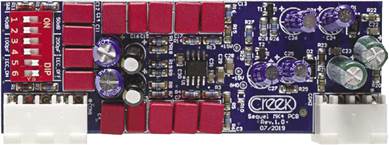
Pro) brought up a declared menu from the AKM chip that 768kHz sample-rate is available: I’d suggest setting a Mac to 96kHz output sample-rate in its AudioMidi Setup menu. But good to see the abilities of the AKM declared and available; the TOSLINK optical inputs work up to 192kHz I found during tests, important to avoid silence from – say – a digital portable player optically connected (e.g. Astell&Kern) and playing a 192kHz sample rate file.
The volume control at right can be pressed to Mute and the remote also provides this function. There is a balance control too. You get a standard 1/4in (6.3mm) headphone socket on the front panel driven by its own amplifier, with the ability to mute the loudspeakers whilst headphone listening. Geeks can even check out heatsink temperature, 28 degree C in our case, the thermal limit being 90 degrees C. Protection circuits guard against overheating, d.c. offset and over-current. The output stage is Class G, meaning a small amp supplemented by a larger one to
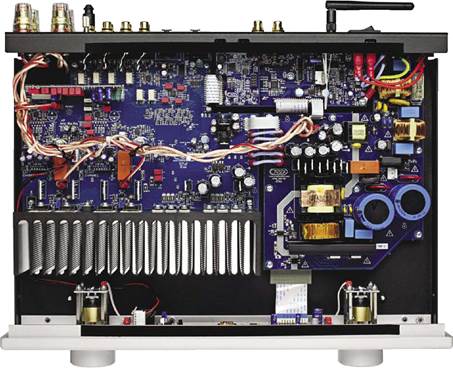
handle peaks, a small G logo lights up in the display when this happens; I got it to do so, but only at shatteringly high volume.
There’s a Bluetooth short-range radio link that connected immediately from my iPhone 10X with no codes or difficulty.
SOUND QUALITY
I ran the i20 with our Martin Logan ESL-X hybrid electrostatic loudspeakers and also used it with the B&W and Triangle loudspeakers in this issue, to see how it fared with different loads. A useful feature of the Evolution 100A as a review amplifier was its compatibility with all loudspeakers.
Source was our Oppo UDP- 205 D universal player acting as CD transport, connected by a QED glass fibre optical cable (I use optical rather than

electrical to avoid earth loop noise). Hi-res digital was fed in via USB from a MacBook Pro running from battery (no charger connection), again to avoid earth loop noise that measurement shows degrades DAC dynamic range. I used the Audirvana+ player to deliver DSD.
It’s sort-of difficult to describe a Creek amplifier. “Quietly powerful” perhaps. A small start and steerage in the right direction. Creek amplifiers were never a sonic assault course, so much as a refined way to listen to music, underpinned by bass strength that gives a sense of underlying power – and the i20 stated its ability here immediately. With one of my bass test tracks, Safri Duo’s Samb Adagio (CD), the pounding synth was as heavy and solid as I could wish for – and there was a feeling of subsonic power to it as well. Although the amplifier has a very high damping factor it didn’t sound dry and tight as many do, just thunderous. There was good bass control and expression, obvious in string bass lines with humans involved, such as that behind Holly Cole singing the laconic Train Song. Here the amplifier dug out some texture in the bass as well as giving it strong dynamic push.
Plenty of fine detail was mined from the vivid guitar of Nils Lofgren’s Keith Don’t Go, our ESL-X XStat panels loving what they were fed. The furiously strummed strings slashed out of the ‘speakers, as they should, but the Creek sounded deliciously sweet; I believe AKM’s Velvet Sound DAC contributed strongly here.
At this point I was also aware of a solid, cohesive sense to the sound that comes from a good digital amplifier with DAC tightly connected to the amplifier stages, with no intervening cables and connectors that hamper an external DAC. The only caveat here being I hear this on the XStat panels that are free of loudspeaker phase anomalies, but not on conventional dynamic loudspeakers that are just a hopeless mess in this respect. If you have a panel loudspeaker though, Magneplanar or Martin Logan perhaps, this is a digital amplifier worth hearing.
Spinning LP was a must, so I connected up our Timestep Evo modified Technics SL-1210 Mk2 Direct Drive turntable, with SME309 arm and an Audio Technica VM750 SH moving magnet (MM) cartridge. There was total silence until needle hit groove and I got to hear a rich rendition of Dire Straits Brothers In Arms (Mobile Fidelity, 45rpm) with firm bass line underpinning Ride Across The River. Hugh Masekela’s Uptownship, from his LP Hope, came across as vividly clear and punchy yet confidently relaxed, the bass line striding along with easy strength. Since Creek also make fine phono stages it was unsurprising the i20 would be strong here, using their Sequel Mk4 MM board.
Running via Bluetooth from an Onkyo player on my iPhone the sound was a tad bland, likely from the compression Bluetooth uses, but I noticed it was slightly warmer and fuller than from the other digital inputs or LP, the Creole singers behind Mercedes Sosa in Misa Criolla occupying what seemed cavernous warm space behind him.
DSD from the MacBook Pro brought up clear indication that the i20 was receiving DSD64 or 128 on its display (I didn’t try any higher) and Diana Krall’s Narrow Daylight was, on Wide filter, more sharp edged and vivid than I recall, but Narrow filter brought back the usual easy balance here. However, I preferred Wide – and as always with DSD well resolved (Japanese chip – they take it seriously) there was a subtly more even and expansive delivery of analogue nature than PCM. Digging out more edgy detail in this smoky performance that slid out from our electrostatics.
It’s a good heads-up to talk about negatives, but there are none other than the i20 is not dry and tight like amplifiers from Chord Electronics, Musical Fidelity, Yamaha and others. It has great bass grip but also warmth – and it thunders better: Willy DeVille singing Spanish Harlem loomed large in front of me, less chiselled in outline and hard in definition, more full bodied and organically natural. Neil Young’s acoustic guitar in After The Goldrush was conspicuously fleshed out to have body and scale. An easy but satisfying sound I felt, but then, being a valve amp man, you might expect that.
Bringing up another small observation. The Creek had a similar milieu to our Icon Audio Stereo 30SE single-ended valve amplifier. It has a broad timbral palette – broader than most – plus an easy naturalness. Both also have a sense of warmth and body in their sound, something that is apparent with string instruments such as Nigel Kennedy’s Stradivarius violin playing Massenet’s Meditation, as well

as a range of close-miked acoustic guitars of Rock that I span through the system. Transistor amps don’t have the spaciousness of valves, but that apart the two were quite close in basic character.
CONCLUSION
I think the Creek i20 justifies being in the ‘premium product’ category. It offers a svelte alternative to others around it, and the digital section is well honed. Tis a pity that at the price it slips out of easy mortal grasp, unlike the CAS4040 I well remember – and was so popular in its time. But that amplifier introduced the fluid Creek sound and the new i20 continues the tradition, now with a lot more wallop and fancy digital technology. Certainly an amplifier to hear for its smooth charms and thunderous sound.
MEASURED PERFORMANCE
The Creek Voyage i20 produced 120 Watts into 8 Ohms and 225 Watts into 4 Ohms – powerful considering its compact dimensions. Output impedance measured 0.04 Ohms giving a very high damping factor of 180, suggesting well controlled bass.
Frequency response of the amplifier via Line input ran from a low 2Hz to 53kHz our analysis shows. Distortion was low at 0.007% in the midband, rising to 0.1% at 10kHz, some crossover distortion appearing at and below 1 Watt.
Input sensitivity was low at 700mV via Line in and 1.4V via XLR in. However, gain can be increased by up to +12dB (x4) bringing Line to 175mV – very high sensitivity.
The digital section was strongly band limited to 20kHz (-1dB), output rolling down to the 96kHz upper limit for 192kHz sample rate PCM via both optical and electrical S/PDIF inputs with all filters. This will give a mild subjective balance.
With CD (44.1kHz PCM) the filters had substantial effect, ‘Natural’ rolling off treble to -1dB at 10kHz.
Distortion (24bit, -60dB) was low at 0.04% from both loudspeaker and preamp outputs, and EIAJ Dynamic Range high at 116dB via both outputs – good if not up to the 123dB figure quoted by AKM for the AK4493EQ DAC chip.
The MM phono stage was insensitive, needing 6mV for full output, falling to 1.5mV with +12dB gain selected. Equivalent input noise – a true measure of perceived noise – was normal enough at 0.47muyV. Frequency response was flat from 10Hz to 20kHz without the IEC warp filter, or -1dB at 50Hz with warp filter, giving -14dB attenuation at 5Hz to suppress warp signals.
The compact Voyage i20 was powerful and measured well all round, if with digital dynamic range below that possible from the AKM DAC. NK
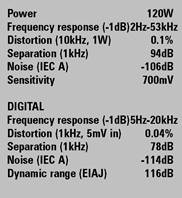
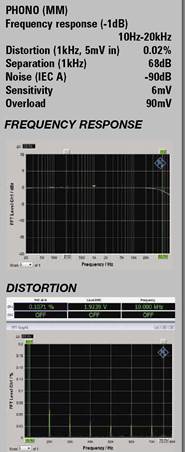
OUTSTANDING – amongst the best.
VERDICT
Creek Audio Ltd +44 (0)1442 260146 www.creekaudio.co.uk



